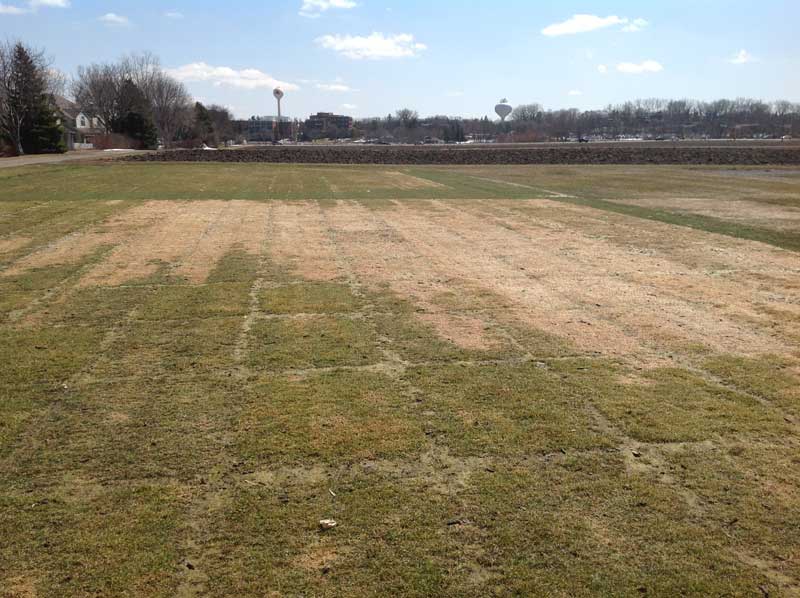By Dr. Lindsey Hoffman ([email protected])
Perennial ryegrass plot injury from ice damage at the U of M Turfgrass Research, Outreach, and Education Center following the winter of 2013. Photo: Sam Bauer
As spring finally arrives and temperatures slowly begin to increase, many of you are faced with repairing turfgrass areas that were injured from this past winter. Compared to last winter (or lack thereof), this year we were faced with temperature fluctuations above and below freezing, excessive rainfall followed by freezing temperatures, and significant snowfall events during the months of April and beginning of May. Although cool-season turfgrasses are adapted to such ‘winter-like’ conditions, certain species and cultivars may still be susceptible to winter injury. Therefore, it’s important to understand the factors contributing to winter injury and the efforts being made towards the development of cool-season turfgrass cultivars with improved winter hardiness.
Winter injury can result from a combination of factors including tissue hydration or desiccation, low temperature fungi, anoxia, and freezing temperatures. Among these factors, tolerance to freezing temperatures has been identified as a major component of winter hardiness across many plant species including turfgrasses. Overall, freezing tolerance is determined by the ability of plants to cold-acclimate in the fall and by the capacity of plants to maintain freezing tolerance throughout the winter and early spring. Both cold acclimation and maintenance of freezing tolerance are influenced by environmental conditions (such as temperature and moisture) and the genetics of the plant (such as the species or cultivar).
As we all know, it is impossible to control the weather; however, it is possible to breed turfgrass cultivars with increased freezing tolerance and better winter hardiness. The process of selecting improved plants involves multiple years of screening in the field under natural conditions as well as screening in a laboratory using controlled freezing tests. Although these processes are both time consuming and cumbersome, they are the best methods for identifying winter hardy plant material. Consequently, the development and release of improved cultivars is a very slow process. For example, it took over 5 years of screening for the development of ‘Arctic Green’ perennial ryegrass, which is a cultivar with improved freezing tolerance that was released by the University of Minnesota in 2007.
Currently, research efforts within the University of Minnesota turfgrass breeding program are focused on identifying more efficient screening methods that can be used in conjunction with field and laboratory testing. In particular, one potential method will be used to decipher between freezing-tolerant and freezing-sensitive plants by comparing levels of different compounds within the plant. Preliminary data suggests that this method may be a useful breeding tool, which would help limit the amount of plant material being evaluated under field and laboratory conditions. Overall, using multiple screening methods will expedite the process of plant selection and development of cool-season turfgrass cultivars with improved freezing tolerance and winter hardiness.
In summary, winter injury associated with freezing temperatures can be a problem for certain cool-season turfgrass species. Breeding of turfgrass cultivars with improved freezing tolerance, therefore, is imperative for helping mitigate the extent of damage that may occur on a yearly basis. Altogether, new screening techniques being developed at the University of Minnesota will help to advance the breeding process and will hopefully lead to faster release of cultivars with better overall winter hardiness.
